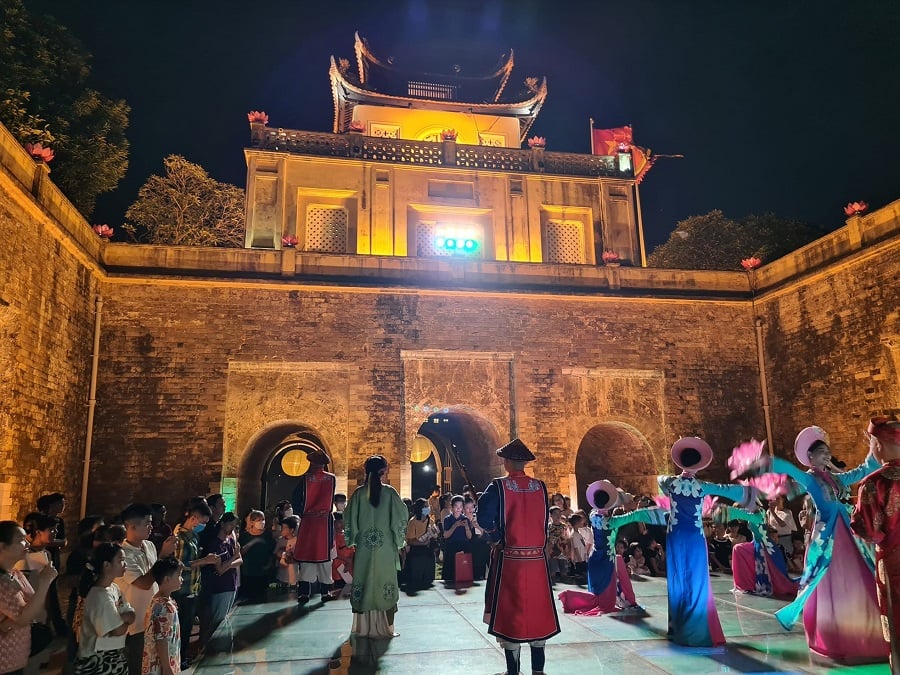
The Imperial Citadel of Thang Long holds a special place in the hearts of those who love exploring a thousand years of Vietnamese history. Each historic point has its own story to tell, making it a truly fascinating experience. Read on to discover what awaits your Hanoi travel exploration.
1. When was the Imperial Citadel of Thang Long built?
- Address: 19C Hoang Dieu Street, Dien Bien Ward, Ba Dinh District, Hanoi City.
In the 11th century, the Ly Dynasty of Vietnam constructed the Imperial Citadel of Thang Long, a significant milestone signifying Dai Viet's emergence into independence. This monumental structure was erected on the foundation of a Chinese fortress dating back to the 7th century. For nearly thirteen centuries, it held the pivotal role of regional political dominance.
Remarkably, the Imperial Citadel of Thang Long in Vietnam's capital was declared one of Vietnam's ten special national heritage sites in 2009 and was added to the UNESCO World Heritage List in 2010. Its universal significance lies in its enduring historical importance, continuous role as a seat of power, and rich cultural layers.
2. Historical and cultural values of Hanoi citadel
Regarding historical values, the Imperial Citadel of Thang Long relics and artifacts depict a consistent history of governance, economy, and culture through successive dynasties. This history spans from the ancient capital Dai La of An Nam in the 7th to 9th centuries, under the domination of the Chinese Tang Dynasty. It continues through the transformation into Thang Long Forbidden City during the Ly, Tran, Early Le, Mac, and Late Le dynasties, followed by the establishment of Thang Long - Hanoi in the 19th century under the Nguyen Dynasty. This historical significance persisted through the French colonial era and up to the present day.
In discussions of cultural value, the artifacts found at the heart of the Imperial Citadel of Thang Long in Hanoi are remarkable proof of enduring cultural exchange. This site has absorbed cultural influences from China, Champa, and France. The creation of landscapes, the layout of palace areas, architectural art, and court decoration showcase diverse cultural developments across different historical eras.

>>> Learn more about the Hanoi symbol before making your visit!
3. What to see in the Imperial Citadel of Thang Long?
3.1. The main gate (Doan Mon)
Doan Mon is positioned to the south of Kinh Thien Palace, aligned with the Hanoi Flag Tower on the same axis. Constructed with stones and bricks, the main gate has a U-shaped structure, featuring five gates symmetrically placed along a central axis, often referred to as the "righteousness axis" of the Imperial Citadel. The primary architectural element of Doan Mon follows a watchtower gazebo design with three rolling arches. The use of rolling arch architecture not only bestowed elegance but also provided exceptional load-bearing capabilities. In contemporary times, Doan Mon, with its impressive and intricate architectural design, has become an ideal location for numerous tourists exploring the Imperial Citadel of Thang Long to capture memorable moments.
3.2. Northern gate (Cua Bac)
Chinh Bac Mon, also known as Cua Bac, stands on Phan Dinh Phung Street. It is the sole surviving entrance to the Hanoi Citadel under the Nguyen Dynasty, which was reconstructed in 1805 atop the Le Dynasty's Northern Gate foundation.
Perched atop the gate is a watch tower gazebo where the imperial troops had a clear view of both the citadel's surroundings and its interior, allowing them to monitor the enemy's movements.
Today, partial restoration is ongoing to honor Hanoi Citadel's history and figures like Nguyen Tri Phuong and Hoang Dieu, who heroically sacrificed during the defense of Thang Long Royal Citadel against the French.
3.3. Hanoi Flag Tower
Located on Dien Bien Phu Street, the Hanoi Flag Tower was constructed in 1812 under the rule of King Gia Long in the Nguyen Dynasty. This is one of the few architectural structures in Hanoi that was fortunate enough to escape destruction by the French colonial rule during the years 1894-1897.
On October 10th, 1954, the red flag with a yellow star, the National Flag, was hoisted atop the Hanoi Flag Tower for the first time. This event marked a historic moment of significance: the day Hanoi was entirely liberated. The tower itself was recognized as a historical monument in 1989.

3.4. Kinh Thien Palace
The Kinh Thien Palace, where King Le Thai To ascended to the throne in 1428, later served as the venue for significant court ceremonies, reception of foreign dignitaries, and vital national affairs discussions.
Throughout its history, Kinh Thien Palace has consistently held a central role within the Imperial Citadel of Thang Long. The foundation and threshold that still exist today are modest remnants of the palace architecture from the Le Dynasty, offering partial insights into the grandeur of the Kinh Thien Palace in the past.
3.5. Lady Pavilion
Hau Lau, formerly known as Tinh Bac Lau (meaning the palace that keeps the North at peace), spans about 2,392 square meters. It emerged after the Later Le dynasty and served as the living and daily activity quarters for queens and princesses.
The palace was constructed using bricks, and its roofs were designed in the traditional Vietnamese architectural style, featuring multi-level roofs adorned with crescent-shaped blades.
The French often referred to Hau Lau as the "Pagoda des Dames" (pagoda of women). In the late 19th century, Hau Lau suffered severe damage. However, it was later restored and rebuilt by the French, retaining its current appearance.

3.6. D67 Revolutionary House
D67 Revolutionary House was constructed on the northern grounds of Kinh Thien Palace, also known as the General Headquarters. This was where vital and strategic plans were formulated, providing opportunities for the nation to undertake the resistance war against the United States.
D67 Revolutionary House is currently preserved and utilized to contribute effectively to the construction and development of Vietnam's revolutionary heritage.
3.7. Archaeological sites
Within this region, archaeologists have uncovered diverse architectural structures and artifacts spanning a timeline of over 1300 years. These layers of relics accumulated quite continuously over time, beginning with the Dai La Dynasty (7th - 9th century) and ending with the Nguyen Dynasty (1802-1945). This remarkable feature greatly contributes to the exceptional value and distinctiveness of these relics.

>>> Explore what to do in Hanoi for 5 days and plan a seamless itinerary!
4. Important information for your first visit to Thang Long Citadel
4.1. Hanoi Citadel opening hours and entrance fees
As you plan your visit to this Imperial Citadel of Thang Long, the following information will guide you through our opening hours and entrance fees, ensuring you make the most of your journey through time.
- Imperial Citadel of Thang Long entrance fee:
- Adults: 30,000 VND per person.
- Students aged 15 and above (with student ID) and senior Vietnamese citizens aged 60 and above (with ID or other documents proving their age): 15,000 VND per person.
- Children under 15 years old and individuals who have contributed to the revolution: Free admission
- Visiting hours: From 8:00 AM to 5:00 PM daily
4.2. Special tours & activities in Hanoi Imperial Citadel
With a great number of tourists visiting the Imperial Citadel of Thang Long each year, a lot of tours serving foreigners and locals have been carried out. These tours not only provide insightful information about the site but also offer engaging cultural experiences.
- A night at the Ancient Imperial Citadel: As you register for this tour, you will have a chance to explore the Imperial Citadel of Thang Long aglow in the night, partake in the ancestral incense ceremony at Kinh Thien Palace, engage in the Imperial Citadel Decoding game with meaningful gifts, and so on.
- Tours suitable for foreign tourists: There are tours designed for foreigners where you can take photos in royal costumes, visit and listen to historical stories about various relics, watch folk art performances, and immerse yourself in folk culture at the souvenir stalls.
- Tours for domestic tourists: These tours are similar to the ones for foreign tourists; however, visitors will also have the opportunity to take part in an incense offering ceremony at Kinh Thien Palace and release birds to pray for peace and tranquility.

The Thang Long - Hanoi Heritage Conservation Center enhances the Imperial Citadel of Thang Long's experience by organizing cultural events and annual festivals, including Lunar New Year and Mid-Autumn Festival celebrations. The old Citadel Hanoi also hosts significant cultural events like the Hanoi Craft Village Tourism Festival, Hanoi Ao Dai Festival, and Hanoi Book Fair. Key annual events include the Mid-Autumn Festival Experience Program and the Vietnamese New Year Program.
4.3. Directions to the Imperial Citadel of Thang Long
The site is located in the heart of Hanoi, which is about 2 kilometers from the center of the Old Quarter. You can book a tech-based motorbike or taxi for the most convenience, or hire a motorbike to get there yourself.
The main gate lies at 19C Hoang Dieu Street, so make sure you arrive at the right location.
Also, from the Imperial Citadel of Thang Long, you can take a short walk to reach other attractions like Cua Bac Church, Quan Thanh Temple, and the Vietnam Military History Museum.
4.4. Extra notes
As this is a historical site, there are a few rules that you need to comply with when visiting the Imperial Citadel Hanoi:
- It is required to wear appropriate clothes, so you should avoid shorts, skirts, tank tops, transparent clothing, etc.
- Be aware of protecting historical relics and artifacts, maintaining environmental cleanliness, and disposing of trash in the designated areas.
- Park your vehicles in the designated area (at 19C Hoang Dieu).
- Do not use a flycam during your visit to the place.

The Imperial Citadel of Thang Long is conveniently located near famous landmarks in the capital, such as the Temple of Literature, Ho Chi Minh Mausoleum, One Pillar Pagoda, Ba Dinh Square, Hoa Lo Prison, Hanoi Old Quarter, Presidential Palace, etc.
Hanoi also provides a range of thrilling recreational choices. VinKE & Vinpearl Aquarium Times City and VinWonders Wave Park & Water Park offer exhilarating experiences suitable for visitors of all age groups. With interactive displays and exciting water rides, these destinations offer a blend of modern entertainment and cultural activities!
>>> Book tickets to VinKE & Vinpearl Aquarium and VinWonders Wave Park & Water Park to get the best experience while visiting Hanoi!
If you are eager to explore Vietnamese culture, don't miss the chance to visit Hanoi, Phu Quoc, Nha Trang, Hoi An, and Ha Long. These destinations allow you to deeply immerse yourself in Vietnamese life and enjoy stunning landscapes.
During the trip, you can consider Vinpearl for your accommodation in Vietnam, as it offers a wide range of amenities, including luxurious dining, grand swimming pools, spa treatments, exotic entertainment, and more. Alongside natural and historical attractions, be sure to experience the excitement of VinWonders, one of Vietnam's largest entertainment complexes, featuring thrilling games, immersive shows, and imaginative worlds.

>>> Book rooms in Vinpearl Phu Quoc, Vinpearl Nha Trang, Vinpearl Resort & Golf Nam Hoi An, Vinpearl Resort & Spa Ha Long and enjoy a pleasant stay in Vietnam!
Hanoi Citadel serves as more than just a testament to a thousand years of glorious history; it also encapsulates the diverse cultures that have thrived through various periods of change. During your visit, be sure to conduct some research to gain a deeper understanding of the Imperial Citadel of Thang Long Hanoi. Hopefully, this article has helped you glean valuable tips for exploring this historic site.
























